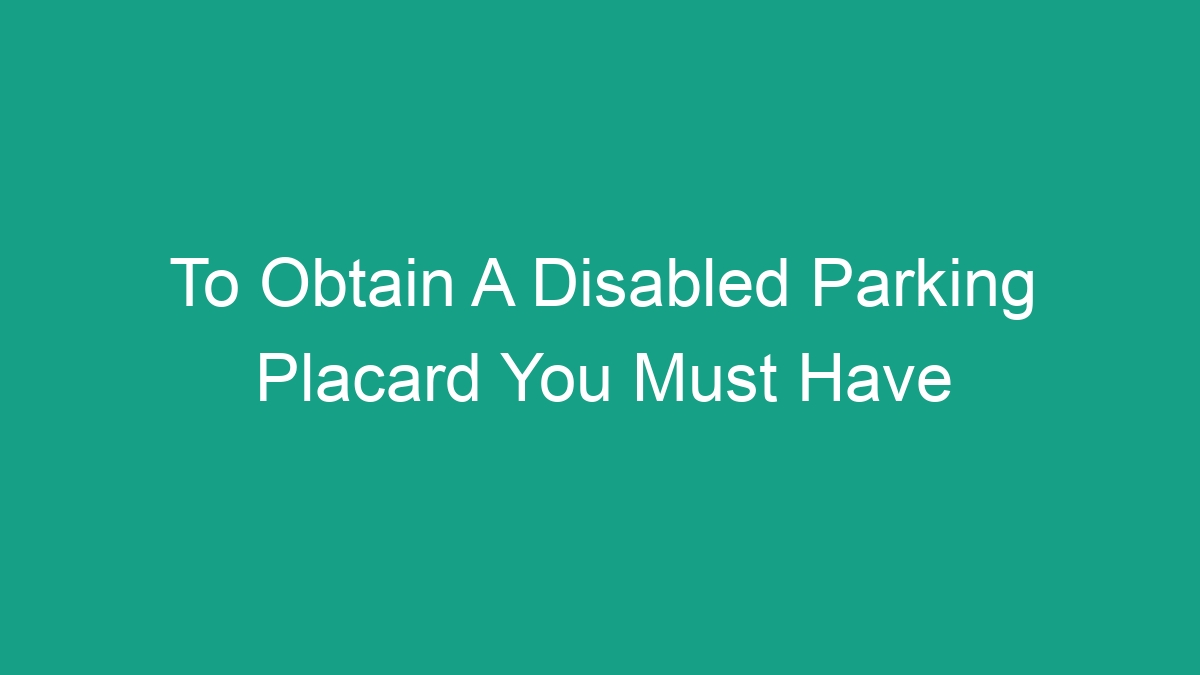
Introduction
Obtaining a disabled parking placard is essential for individuals who have disabilities and need accessible parking spaces. Disabled parking placards allow people with disabilities to park in designated accessible parking spots, making it easier for them to access essential services and facilities. In this comprehensive guide, we will discuss the requirements and process for obtaining a disabled parking placard.
Eligibility for a Disabled Parking Placard
Before applying for a disabled parking placard, it is important to understand the eligibility criteria. Eligibility for a disabled parking placard varies by state or country, but in general, individuals with disabilities that substantially impair their ability to walk may qualify for a placard. Some common qualifying conditions include:
- Being unable to walk 200 feet without stopping to rest
- Using portable oxygen
- Being unable to walk without the assistance of a cane, crutch, wheelchair, or other device
- Having a severe cardiac condition
- Having a severe lung disease
- Being legally blind
It’s important to check the specific eligibility requirements in your state or country before applying for a disabled parking placard.
Documents Required for Application
When applying for a disabled parking placard, you will need to provide certain documents to prove your eligibility. The specific documents required may vary by location, but commonly required documents include:
- A completed application form
- A prescription or statement from a healthcare provider verifying your disability
- Proof of identity, such as a driver’s license or state-issued ID
- Vehicle registration and/or title
It’s important to carefully review the application requirements in your state or country to ensure you have all the necessary documents for your application.
Application Process
The application process for a disabled parking placard also varies by location, but it typically involves the following steps:
- Obtain the necessary application form from your state’s Department of Motor Vehicles (DMV) or a similar agency.
- Complete the application form, providing all required information and documentation.
- Submit the completed application form and supporting documents to the appropriate agency. This may involve mailing the documents, visiting a DMV office in person, or submitting the application online.
- Pay any required fees for the placard, if applicable.
- Wait for your application to be processed. Once approved, you will receive your disabled parking placard.
It’s important to follow the specific application instructions provided by your state or country to ensure a smooth and successful application process.
Types of Disabled Parking Placards
There are typically two types of disabled parking placards: temporary placards and permanent placards.
Temporary placards are issued to individuals who have a temporary disability that impairs their mobility, such as a broken leg or recovering from surgery. These placards are typically valid for a limited period, such as six months, and may require renewal if the disability persists.
Permanent placards are issued to individuals with long-term or permanent disabilities that substantially impair their ability to walk. These placards are usually valid for an extended period, such as several years, before requiring renewal.
It’s important to understand the distinction between temporary and permanent placards and ensure that you apply for the appropriate type based on your specific circumstances.
Using a Disabled Parking Placard
Once you have obtained a disabled parking placard, it’s important to understand how to use it properly. When parking, always display the placard on your vehicle’s rearview mirror or dashboard, making sure that it is clearly visible. Additionally, be mindful of parking regulations and use the placard only when actively transporting the individual with the disability.
It’s crucial to follow all applicable parking laws and regulations while using a disabled parking placard to avoid fines or penalties.
FAQs
Here are some common frequently asked questions about obtaining a disabled parking placard:
Q: Can I use a disabled parking placard in a different state or country?
A: In most cases, yes. Many states and countries have reciprocal agreements recognizing disabled parking placards from other jurisdictions. However, it’s important to check the specific regulations in the area where you plan to use the placard.
Q: Can I lend my disabled parking placard to someone else?
A: No, disabled parking placards are issued to individuals and are not transferable. It is illegal to lend your placard to someone else or use someone else’s placard.
Q: What do I do if my disabled parking placard is lost or stolen?
A: If your placard is lost or stolen, you should contact the issuing agency immediately to report it. They can provide instructions for obtaining a replacement placard.
Q: Can I use a disabled parking placard if I am not transporting the individual with the disability?
A: No, a disabled parking placard is only valid when the individual with the disability is being transported. It is illegal to use the placard for personal convenience or without the individual present.
Q: How can I renew my disabled parking placard when it expires?
A: The process for renewing a disabled parking placard varies by location. You may need to submit a new application or follow specific renewal instructions provided by your state or country’s DMV or similar agency.
Q: Can a healthcare provider refuse to provide the necessary documentation for a disabled parking placard?
A: While rare, it is possible for a healthcare provider to refuse to provide the required documentation. In this case, you may consider seeking a second opinion from another healthcare provider or discussing the matter with the issuing agency.
In conclusion, obtaining a disabled parking placard requires meeting specific eligibility criteria, providing necessary documentation, and following the application process outlined by your state or country. It’s essential to use the placard responsibly and follow all applicable regulations to ensure accessibility for individuals with disabilities. If you have any further questions about obtaining a disabled parking placard, consult your state or country’s DMV or similar agency for guidance.



